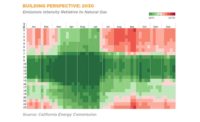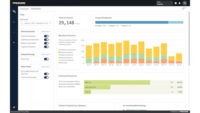In Europe, where more corporate and public sector building owners are seeking to meet net-zero carbon targets, new tools are emerging that assess and manage embodied and operational emissions in new and existing structures. A Finnish team is integrating carbon data with structural design, while a U.K. firm is offering a one-stop-shop service for retrofitting existing assets.
"I’ve been waiting for [something like this] for as long as I've been in the industry," says Kari Nöjd, sustainability technology manager at engineering firm Sweco Rakennetekniikka Oy, which is designing a roughly $30-million extension to a sports center in Imarat, Finland.
Nöjd's enthusiasm is for a system that allows designers to understand instantly the embodied carbon impacts of their structural and materials choices. The Imarat project is piloting the system.
Instead of focusing only on cost and schedule, more owners also are "asking which alternative has the lowest embodied carbon, and that is something structural designers need to be able to answer," he says.
Speedy Assessments
Sweco helped to integrate digital design packages from software firm Trimble Inc. with the vast database of construction material embodied carbon levels held by the Finnish company One Click LCA.
Previously, designers compiled project carbon data in spreadsheets and uploaded them to the firm, says Panu Pasanen, company president. Integrating design software with the database is "about 10 times faster ...that allows people to do [carbon analysis] more often, earlier and on more projects," he adds.
One Click LCA can produce result reports that show compliance with any of more than 60 sustainability standards and specifications, such as the U.S. LEED, says Pasanen.
The firm and Trimble launched the system in 2016, "but the structural engineering profession ... was not sensitized to the need and opportunities," recalls Pasanen. "The market has changed quite significantly since then."
A subsequent relaunch with Trimble's Tekla design and detailing software and and its collaboration platform was more warmly received. Now the two companies are training users in eight countries, says Pasanen.
Reducing embodied carbon can have a big effect long term "We are roughly doubling global building stock in the next 40 years," says Pasanen. "This is going to create carbon emissions that equate approximately to six years of global energy carbon emissions ... [and] it's all up front," he adds.
'Dramatic Effects'
Providing structural designers with information early in the design process "can have dramatic effects on carbon," adds Dietmar Grimm, Trimble vice president of sustainability solutions. "If you don’t give that information early and easily to [designers], then in many sectors right now, people just won’t do it."
With its design nearing completion, the Imatra sports hall will be among Finland's first structures "trying to reach carbon neutrality," says Sweco's Nöjd. Finnish legislation due by 2025 will require owners of new buildings and most major renovations to demonstrate compliance with mandated carbon footprint limits, he adds.
But embodied carbon is only part of the story. "Decarbonizing existing buildings is probably where the majority of carbon abatement is going to need to come from," says Stuart McLaren, director for net zero infrastructure at U.K.-based Atkins, part of the SNC-Lavalin Group.
Most of the built environment in 2050 exists today, and "50-70% of those buildings are going to need medium to deep retrofit in order to deliver a net-zero future," he adds.
To tackle this growing demand, Atkins has pooled in-house expertise, tools and carbon databases into a new service it calls Decarbonomics.
The package basically aims to establish the existing emissions of an owner's portfolio of buildings, and benchmark them with reference to industry equivalents. The Atkins team then develops a strategic and detailed investment plan, including costs, schedule and other factors.
"For each building ... it also will show you what your program of delivery should look like and it's also providing all cost information you would need to be able to develop your ... business case. That's where we find our clients’ biggest challenges are," says McLaren.
"Typically it works better [with] over 20 buildings or so," he says, adding that often a small portion of a portfolio accounts for most of the emissions. In that case, the team can "illustrate very quickly where you want to focus your efforts," McLaren says.
UK Out in Front
For this service, the U.K. "is probably the leading market," says McLaren, with the public sector taking the initiative. Atkins last summer was appointed by the U.K. Government Property Agency to manage, for six years, its sustainability improvement work program on more than 400 buildings. "The way we established the approach ... ended up forming the nucleus of the Decarbonomics concept," he adds.
McLaren also sees growing interest in the service in Middle Eastern and Australian private sector markets. The company is talking with "a whole array of clients across the U.S and Canada," although the public sectors in those two countries are a "little bit behind," he adds.
In developing decarbonization strategies, McLaren is keen to get away from conventional procurement routes and adopt "more outcome-based commercial and contracting models."
With greater confidence in the data collection, particularly in the baseline and benchmarking, the supply chain can be engaged collaboratively, he hopes. "We can put our own skin in the game to help drive a much stronger partnership approach."






Post a comment to this article
Report Abusive Comment